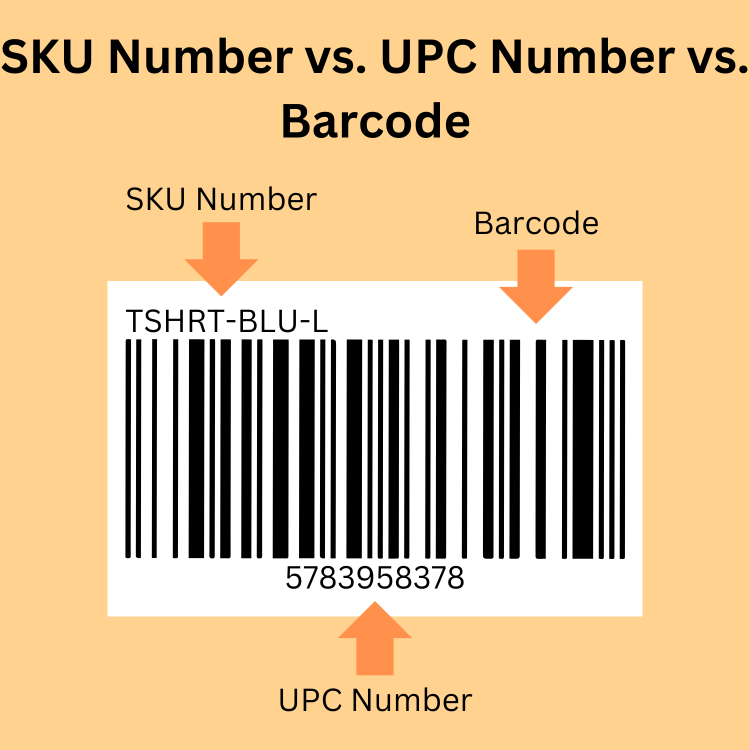What is a SKU Number? [2024]
Simplify Inventory and Boost Efficiency with This Essential Guide to SKU Numbers.
Simplify Inventory and Boost Efficiency with This Essential Guide to SKU Numbers.

A SKU, or Stock Keeping Unit, is a unique alphanumeric code that businesses use to identify and track products in their inventory. Unlike barcodes or UPCs, which are universal and assigned by manufacturers, SKUs are custom-created by businesses to organize their inventory and manage operations more effectively.
SKUs act as shorthand for product details such as category, brand, size, color, and location. For instance, a SKU like “SHOE-BLK-8” could represent a black shoe in size 8. This simple yet powerful system allows businesses to quickly locate, track, and manage products across warehouses, stores, or eCommerce platforms.
The importance of SKUs goes beyond inventory tracking. They enable businesses to:
Whether you run a small online store or a large retail chain, implementing a good SKU system can transform your inventory management process, ensuring smoother operations and a better customer experience.

SKU stands for Stock Keeping Unit, a term widely used in retail, eCommerce, and supply chain management. It is essentially a unique identifier for a product, enabling businesses to distinguish items at the most granular level. While barcodes and UPCs serve as universal identifiers for products across industries, SKUs are internally generated, giving businesses the flexibility to create codes that align with their specific operations.

SKUs are often confused with other product identifiers like barcodes or ASINs (Amazon Standard Identification Numbers), but they serve different purposes:
Unlike barcodes and UPCs, SKUs provide meaningful information at a glance. For example, “TSHRT-BLU-L” tells you it’s a large blue T-shirt, making it easy for staff to identify products without needing additional details.
A well-constructed SKU number typically includes:
For example, a SKU like “SHOE-BLK-9-2023” might represent black shoes in size 9, produced in 2023. This structured format simplifies inventory tracking and ensures no two products share the same code.
By integrating SKUs into your inventory system, you gain not only better organization but also the ability to scale operations with efficiency. They form the backbone of inventory management for businesses large and small, making processes like stocktaking, order fulfillment, and reporting far more effective.
SKUs make it easy to organize, track, and locate products across your inventory. By assigning a unique code to every item, businesses can quickly identify stock levels, locations, and variations. This system reduces the chances of misplacing items or mismanaging stock, particularly in high-volume operations. For example, if you sell shoes in multiple sizes and colors, SKUs let you differentiate between “SHOE-BLK-8” (black, size 8) and “SHOE-WHT-9” (white, size 9) without confusion.
Key benefit: Better control over stock levels minimizes overstocking and stockouts, boosting operational efficiency.
SKUs enable faster order processing and accurate fulfillment. When products are organized and easy to find, employees can pick, pack, and ship orders quickly, reducing errors. Customers are less likely to experience delays or receive the wrong product, leading to higher satisfaction and repeat business.
Example: A customer orders a “SHOE-RED-10” SKU online. With a clear SKU system, your team can locate the exact item in your warehouse and ship it promptly.
SKU-specific sales data helps businesses analyze product performance, identify trends, and make data-driven decisions. By tracking which SKUs sell the most or the least, you can adjust pricing, restocking, or marketing strategies accordingly.
For example:
Key benefit: SKU data empowers businesses to optimize inventory, pricing, and marketing for maximum profitability.
Managing inventory across multiple platforms—such as Shopify, Amazon, or Lazada—can be challenging without SKUs. A centralized SKU system ensures your stock levels are synchronized across channels, reducing the risk of overselling or underselling.
Example: Using tools like OneCart, you can update stock in real time across multiple platforms. This way, when an item sells on Amazon, the inventory count automatically updates on Shopify and Lazada, thanks to the shared SKU system.
As your business grows, so does the complexity of managing inventory. A robust SKU system lays the foundation for scaling operations seamlessly. It allows businesses to manage thousands of products with ease, ensuring that even as you expand to new locations or platforms, inventory remains organized.
Key benefit: SKUs reduce the administrative burden, freeing up resources to focus on growth and innovation.
By integrating SKUs into your operations, you gain more than just a tracking tool—you create a foundation for efficiency, data-driven insights, and exceptional customer service. Whether you’re managing a single store or multiple eCommerce platforms, SKUs are essential for sustainable success.

Creating effective SKUs requires a structured approach to ensure clarity, uniqueness, and ease of use. Follow these best practices:
SKUs are typically made up of several segments that provide key product details at a glance. Here’s a common format:
Example SKU: “TSHRT-BLU-L”
Manual SKU creation works for smaller inventories, but as your catalog grows, automating the process is essential. Use tools and software to generate and manage SKUs effectively:
Here are a few examples of practical SKU structures for different industries:
By designing clear and efficient SKU systems, you can ensure smoother operations, fewer errors, and better insights into inventory and sales. A well-thought-out SKU system is a long-term asset for any growing business.
SKUs help businesses organize inventory in a systematic way, ensuring that products are easy to locate, track, and manage. By grouping products based on SKU patterns, businesses can simplify processes like restocking and order fulfillment.
Tips for Better Organization:
Example: SKU “TSHRT-WHT-S-L1” could mean a small white T-shirt stored in Location 1.
Using SKUs with real-time inventory tools ensures that stock levels are updated automatically across all channels, reducing the risk of overselling or stockouts.
Key Benefits:
Example: OneCart’s inventory management system tracks SKU levels in real time, syncing data across platforms to ensure consistent stock availability. Learn more about inventory forecasting.
When every product has a unique SKU, it becomes easier for staff to pick, pack, and ship orders accurately. This reduces errors and improves customer satisfaction.
Steps to Streamline Fulfillment:
Example: For an order containing SKU “MUG-RED-M,” staff can quickly locate the medium red mug in the warehouse and prepare it for shipping.
SKU-level data provides actionable insights into sales performance, inventory trends, and profitability. Businesses can use this information to optimize operations and make informed decisions.
Insights Gained from SKU Analysis:
Example: If “TSHRT-BLU-L” consistently sells out, increasing stock or running a targeted ad campaign could boost sales further.
For businesses selling across multiple platforms, SKUs ensure seamless integration and consistency. Assigning the same SKU to a product across platforms helps avoid discrepancies in stock levels and pricing.
How It Works:
Example: A customer purchases SKU “LAMP-WHT-M” on Lazada. The inventory count updates automatically on Amazon and Shopify, preventing overselling.
SKUs simplify customer inquiries and returns by providing a quick way to identify the product in question. Customers can refer to SKU numbers for faster resolutions, ensuring a better experience.
Example: If a customer contacts support about “SHOE-BLK-8,” your team can instantly locate the product details and resolve the issue efficiently.
By effectively using SKU numbers, businesses can streamline operations, improve accuracy, and drive better decision-making. Whether you’re a small business or a growing enterprise, leveraging SKUs strategically ensures smooth inventory management and enhanced customer satisfaction.
A SKU number helps businesses efficiently manage inventory by assigning a unique identifier to each product. It simplifies tracking, organizing, and locating items across warehouses, stores, and eCommerce platforms.
SKUs are typically displayed on product labels, packaging, or listings in inventory management systems. In eCommerce, the SKU may appear in product details on platforms like Shopify or Amazon.
While barcodes are used universally across systems, SKUs are specific to a business’s inventory.
Yes! Even small businesses benefit from SKUs as they improve organization, streamline inventory tracking, and simplify order fulfillment. Tools like OneCart can automate SKU generation, making it accessible for businesses of any size.
Follow these steps:
Duplicate SKUs can lead to inventory errors, fulfillment mistakes, and reporting inaccuracies. It’s crucial to ensure every product variation has a distinct SKU to maintain efficiency.
SKU-level data enables businesses to:
To avoid confusion, it’s best to avoid reusing old SKUs. Instead, archive discontinued products and assign new SKUs to incoming items for clear differentiation.
SKUs unify inventory across multiple sales channels, ensuring consistent stock levels and accurate reporting. Using the same SKU on platforms like Amazon and Shopify helps prevent overselling and simplifies management.
Absolutely! Inventory tools like OneCart automate SKU creation, syncing, and reporting, making it easier to scale operations and manage inventory efficiently.
SKU numbers are essential tools for effective inventory management and business operations. By assigning unique alphanumeric codes to products, businesses can organize stock, track sales, and streamline order fulfillment with ease. SKUs not only help avoid common inventory issues like overstocking or stockouts but also enable data-driven decisions through actionable insights into product performance and customer trends.
Using SKUs effectively:
Whether you’re a small business just starting out or a growing enterprise managing complex inventory, a well-structured SKU system lays the foundation for scalability and operational efficiency. Tools like OneCart can automate SKU management, ensuring consistency, accuracy, and integration across all sales channels.
Ready to take your inventory management to the next level? With OneCart, you can automate SKU creation, synchronize stock across platforms, and gain real-time insights into your business performance.
Automate & Scale Your Online Business with OneCart
Start a Free TrialUsed by hundreds of merchants in Singapore & Southeast Asia